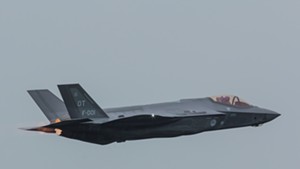The F-35 remains "the right fit" for the Vermont Air Guard, its top officer declared on Thursday — one day after the Winooski city council voted unanimously to oppose local basing of the plane.
During a 90-minute press briefing at Camp Johnson in Colchester, Gen. Dick Harris (pictured) and other Air Guard officers disputed that the F-35 would be significantly louder than the existing fleet of F-16s.
They also challenged the assertion by Vermont medical experts that many local residents exposed to noise levels now produced by the F-16 will suffer negative health effects.
Unless Vermont is chosen to host up to two dozen F-35s, it appears at present that the Air Guard will be left without a mission within the next five to seven years, Harris added. As early as 2018, the F-16 will be withdrawn from operations in Vermont, the general said. "There is nothing hanging out there" as an alternative to the-F35 for the Green Mountain Boys, Harris added. The Air Guard facility at Burlington International Airport will not be included in an Air Force program to extend the lifespan of the F-16, he told reporters.
Noise produced on takeoff by the F-35 will generally not be perceived as four times louder than that generated by the F-16, said Lt. Col. Dan "Gump" Finnegan (pictured), the Vermont Air Guard's squadron commander. He said the four-times-louder comparison in the Air Force's environmental impact statement is based on noise readings when the F-16 is not using its afterburners. But the F-16 has consistently been using afterburners for the past few years. They give it the thrust needed to carry external fuel tanks and thus amplify the noise the F-16 makes on takeoff. The F-35, by contrast, would use afterburners only about 5 percent of the time if it were based at BTV, Finnegan said. Because they hang from a plane's wing, external fuel tanks greatly diminish the stealth capabilities that are integral to the F-35's design, he explained.
The local officials did not dispute the Air Force's finding that as many as 2100 additional homes near the airport will be included in a high-noise zone if the F-35 comes to Vermont. But Adam Wright, environmental manager of the Vermont Air Guard base, said there is no scientific evidence of damage to health from exposure to noise in that zone where sound levels exceed a day-night average of 65 decibels. A panel of Vermont medical experts speaking Tuesday night at a forum organized by F-35 opponents suggested that a variety of health problems, including high blood pressure, can result from living in a zone with noise averaging 65 decibels or higher. Buildings within that zone have been deemed by federal authorities as "not suitable for residential use."
With the F-35, fewer homes in South Burlington would be impacted than are currently hit with F-16 noise. But more homes in Williston and Winooski would fall within the high-noise zone, according to the Air Force's projections.
The Air Guard will be able to mitigate the impact of the F-35's noise on Winooski, Finnegan maintained. "There are a significant number of options for us to move and manipulate and shrink the 65 DNL line," he said, suggesting that takeoff angles and climbing rates could be adjusted to reduce noise levels.
Asked whether more local homes may be purchased and demolished as a result of the F-35's larger noise contours, Air Guard officials said it is up to the airport's civilian directors to make such a decision. They noted that BTV aviation director Gene Richards has said he has no intention of continuing the house buyout program funded by the Federal Aviation Administration. A total of 200 homes within the 65 DNL line in South Burlington have been bought through the FAA program in recent years. They now stand empty or have been demolished.
A final decision on where to base the F-35 will be made in November at the earliest, Wright indicated. Air Guard officials noted that in making the choice, the U.S. Air Force will consider five factors: cost of basing the F-35; a facility's capacity to handle the plane; a base's compatibility with the stealth fighter's mission; "military judgment"; and environmental considerations. BTV scores highest on a combination of the first four factors. Due to the impact of noise, however, the Vermont station ranks second to the McEntire Joint National Guard base in South Carolina on the environmental factor.
In response to some local residents' requests that an F-35 be brought to Burlington to assess its actual noise output, Harris said the Air Guard station lacks the maintenance capability to handle one of the jets. And even if an F-35 could somehow perform demonstration runs at BTV, "I don't know if that would be an objective view of the impact" of the noise made by the plane, Harris added.
In reference to Winooski's declared opposition to the F-35, Harris said the process of choosing a home for the plane is "not a popularity contest." Instead, he added, "it's an attempt to look at the facts." Harris added that he would not argue publicly with those opposed to the F-35. "We don't want to get into a debate," he said.







Comments (13)
Showing 1-13 of 13
Comments are closed.
From 2014-2020, Seven Days allowed readers to comment on all stories posted on our website. While we've appreciated the suggestions and insights, right now Seven Days is prioritizing our core mission — producing high-quality, responsible local journalism — over moderating online debates between readers.
To criticize, correct or praise our reporting, please send us a letter to the editor or send us a tip. We’ll check it out and report the results.
Online comments may return when we have better tech tools for managing them. Thanks for reading.